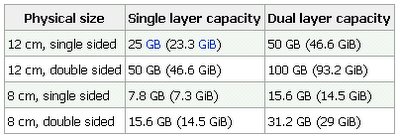
About 9 hours of high-definition (HD) video can be stored on a 50 GB disc. About 23 hours of standard-definition (SD) video can be stored on a 50 GB disc. TDK recently announced that they have created a working experimental Blu-ray disc capable of holding 200 GB of data on a single side (six 33 GB data layers).

Because the Blu-ray standard places the data recording layer so close to the surface of the disc, early discs were susceptible to contamination and scratches and had to be enclosed in plastic caddies for protection. The consortium worried that such an inconvenience would hurt Blu-ray's market adoption in the face of the rival HD DVD standard, as HD DVDs place the data layer farther away from the surface, rather like DVDs. Blu-ray discs now use a purpose developed layer of protective material over the reflective data backing (ie, on the label side)
Both Sony and Panasonic replication methods include proprietary hard-coat technologies. Sony's rewriteable media are sprayed with a scratch-resistant and antistatic coating